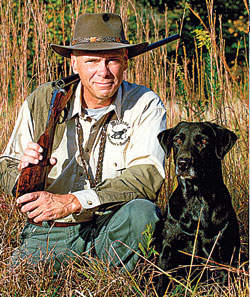By James B. Spencer
 This tip is from Mike Stewart of Wildrose Kennels, 260 CR 425, Oxford, MS 38655; (662) 234-5788; Web site www.uklabs.com; e-mail uklabs@hughes.net. |
"I'm horrified," Mike said, "when I see a dog loose in the back of a pickup. This is a disaster looking for a place to happen. Ditto for a dog loose inside a vehicle, where he can interfere with the driver and cause an accident, or become a flying object in case of an accident--or even dive out of an open window. No, when traveling, dogs should be crated, period."
For dogs traveling within the vehicle, Mike prefers plastic or wire crates. For the back of a pickup, he prefers metal crates. In either situation, the crate should be well-ventilated and large enough for the dog to stand up and turn around comfortably. However, if the crate is too large, the dog can be slammed around in it if you stop suddenly. Whether inside the vehicle or in the back of a pickup, the crate should be secured to the vehicle so it stays in place.
"Each dog should be individually crated," Mike said. "Crating them in pairs encourages sniffing, chewing, playing and occasional disagreements. When unavoidable or in extremely cold weather, I may crate dogs in pairs for brief periods, but that is not my general practice. To do so regularly would encourage undesirable behavior both in the field and at home."
While on the road, Mike airs adult dogs only when he or his hunting buddies feel the need. He feeds them at night and gives them plenty of time to relieve themselves then and again before starting out in the morning. He also stakes them out during his brown-bag lunch breaks.
He recommends taking enough food and water along for the entire trip. He prefers using waterproof food storage bags and no-spill water bowls.
"Don't switch food or water on the trip," he said. "Upset stomachs and vehicle motion are not good bed-fellows."
Mike recommends that you take the following equipment items along: a bright collar with your phone number on it, a lead and a few dummies.
"If you microchip your dog," he said, "you will have a much better chance of recovering him should he get lost."
He recommends the following first aid items: hemostats for removing imbedded objects, scissors for trimming hair if burrs are a problem, stomach-settling medication, hydrogen peroxide for cleaning wounds, antiseptic ointment, buffered aspirin for aches and pains, and whatever else your veterinarian recommends.
When stopping at a restaurant, you should protect your dog from the weather. If it's hot, make sure he has adequate ventilation. If it's cold, park where he's out of the wind (and falling moisture). Keep him securely locked in his crate. If he's crated in your pickup bed, his crate should be chained and locked to the vehicle.
"Then, too," Mike added, "don't leave your truck unlocked with the keys in it, even if you're just stopping for gas."
When staying in a pet-friendly motel room, Mike crates his dog in his room while he's out and overnight. When he's there, he lets him relax on a portable dog bed, using the "place" command. He doesn't feed his dog in his room.
"Noise?" he asked. "I won't keep a noisy dog in a motel room. Such a dog stays outside in my truck."
When staying in a motel that doesn't allow pets in the rooms, Mike parks his truck in a high-traffic area and locks his dogs securely in their crates. He feeds early in the evening and airs them a couple of times before bedtime. He airs them again early in the morning.
"Heat is much more dangerous for dogs than cold," Mike said. "They're fairly safe inside an air-conditioned vehicle. Not so in a pickup bed or dog trailer, where the sun really shines. Fans help. I sometimes douse them with water, or even toss a bag of ice in their crates. I never crate dogs together in warm weather because of their body heat."
Mike listed the signs of overheating as a glazed look in the eyes, rapid panting, tongue heavily cupped and turned up, staggering, unresponsiveness to commands and falling down.
"Many hunters are traveling by air these days," Mike added. "If you do this, check well ahead of time for all the specific airline's rules for taking a dog along. Don't allow yourself to suffer any unpleasant surprises when you arrive at the airport."






